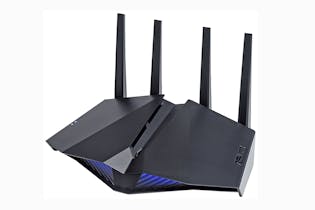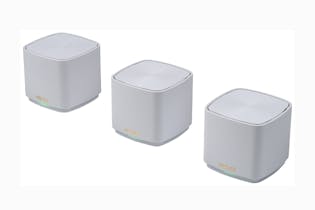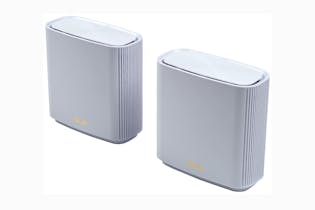WiFi routers, mesh networks & range extenders
We've tested 17 different network devices to see which provide the best WiFi speed, coverage and security. Discover which technology is best for your home.
When your internet is slow or patchy, you have a few options to improve it. You could upgrade to a more capable router, add range extenders to boost the signal to the far corners of your house or link together two or more ‘mesh’ routers.
What’s best for you depends on several factors, including the layout of your home. For example, regular routers might struggle to cover an entire multi-storey brick home, because thick walls and floors interfere with the signal.
How to get the most from your router
If your WiFi performance isn’t up to scratch, here are a few tips to speed things up:
Put your router in the centre of the house. Don’t tuck it away in a cupboard. Placing it out in the open will help keep your speed high.
Use the 5GHz band where possible. Some household appliances such as microwaves operate on the 2.4GHz band, which can interfere with your WiFi. An easy fix is to switch tech devices to the 5GHz network – however, be aware that signal doesn’t travel as far in this band.
Don’t be afraid to use ethernet cables. Wired internet might seem antiquated, but it’s faster than WiFi. Try to run ethernet through a wall cavity if you can – the thick blue cables are unsightly and prone to damage in the open.
Upgrade from the router you were sent. Internet service providers (ISPs) send basic, low-cost routers to customers on fixed term contracts. Buying your own device can give an immediate bump to your WiFi signal and range. Use our test results to find a good option.
For a more detailed explanation of speeds, bands and setups, see our article on getting faster internet.
Mesh routers
In a mesh system, instead of a single router trying to reach every part of your home, several smaller devices work together to form a network. Mesh is perfect for a larger home that would otherwise have WiFi dead-spots.

Most mesh routers are sold as a system with two or three nodes in the pack, but you can buy more to expand the network. Each node is the same, but one will connect to a modem and act as the main unit.
A mesh set-up differs from using a WiFi repeater in that mesh devices form a single network with one SSID (service set ID), whereas a repeater sets up its own network with a separate ID. As you move through a house serviced by mesh, your devices don’t have to switch between networks.
WiFi range extenders
What is a range extender?
WiFi range extenders boost your router’s wireless signal, which allows your home WiFi network to reach further.
There are two types: standalone desktop extenders, which look similar to a router, and smaller extenders which plug straight into a power socket and look like a powered air freshener.
Which you should buy depends on your home’s layout and where you are putting the range extender.
Do you need one?
Unsure if you need a range extender? You can check by moving your wireless router to the most central location in your home and testing its range by monitoring a mobile device’s signal strength while you move away from the router. If the most central place in your home isn’t near your phone jack and modem, then use ethernet cables to get the router as centrally positioned as possible.
We don’t tend to recommend range extenders within a home. In general, we think you’re better off either upgrading to a better router or committing to a full mesh network.
However, there are situations where a range extender makes sense. A sleepout or granny flat is a good example where the main network is far enough away that your devices shouldn’t get confused.
You can daisy-chain range extenders together to reach the extra mile, but the more additional steps there are, the more speed is lost.
The range extenders we’ve tested can act as mesh nodes as well. How you use them depends on the capability of your other routers.
Protect your new router
Change the default SSID and admin password
Routers will often arrive with a default ID that includes the name of your ISP (for example, vodafone1234567). To minimise the risk of someone guessing your WiFi login, change your network’s SSID and admin password immediately.
Encryption
When information is being transferred to or from the internet, it’s at risk of being intercepted, so all routers need secure encryption. The common methods are WPA2 and WPA. If your router is using the older and less secure WEP algorithm, change to a stronger encryption method if you can.
Extra security
Some routers come with a built-in firewall or antivirus. You shouldn’t view the router’s firewall or antivirus as a replacement for these features on your laptop and phone. Think of them as an extra layer of protection.
FAQ
Are routers and modems the same thing?
The terms modem and router are often used interchangeably when referring to home WiFi equipment.
Technically, a modem receives the internet connection, then a router directs that traffic to and from devices. In practice, most consumer devices handle both connecting and routing.
What’s the difference between the 2.4 and 5GHz bands?
WiFi commonly transmits over two radio frequency bands, 2.4 and 5GHz.
The 2.4GHz band is a strong frequency that can reach further than 5GHz, but it can be busy because it’s also used by household devices such as microwaves. Bluetooth also operates on this band.
The 5GHz band is less cluttered as it’s generally only used for WiFi, which means less interference and therefore faster speeds. It also means it can use less power, which lessens battery drain on devices.
A router that can broadcast both bands at the same time (dual-band) gives you the best speeds.
How does tri-band differ from dual-band?
A tri-band router uses a 2.4GHz network and two separate 5GHz networks. Having two 5GHz networks effectively doubles the capacity of the 5GHz band. Tri-band routers often have a feature called smart switching, which allows the router to distribute the workload over both 5GHz networks.
What is WiFi 6 and what do the 802.11 codes mean?
There are a number of standards by which wireless devices can talk to one another over WiFi. The latest and fastest standard is WiFi 6, which runs on both the 2.4GHz and 5GHz bands.
Wireless protocols are based on an original standard called 802.11. WiFi 6 is the first protocol to launch with a catchy, marketable name, but is also called 802.11ax.
802.11ac (2014) has been retroactively numbered WiFi 5. It supports bandwidths up to 1300Mbps on the 5GHz band only.
802.11n (2008) has been retroactively numbered WiFi 4. It supports bandwidths up to 600Mbps on the 2.4GHz and 5GHz bands.
These speeds are theoretical maximums. In reality, routers are unlikely to reach 50% of these rates.
Are external antennae better than internal?
An external antenna can be adjusted to face connected devices, while internal antennae are housed in the router case.
There is little performance difference between external or internal antennae.
Glossary
Mbps: Megabits per second. Data transfer speeds are measured in Mbps. A thousand Mbps is a gigabit per second (Gbps).
SSID: The name of your WiFi network. For security, you should change from the default SSID to a unique one.
LAN: A Local Area Network (LAN) is a network created by connecting devices with cables.
WiFi and WLAN: WiFi and WLAN are names for the wireless version of a LAN. If your router has a WLAN or WiFi button, this will turn the wireless network on and off.
WAN: WAN (Wide Area Network) covers a larger area than LAN or WiFi. Many routers use WAN to describe the fibre connection, so when you’re connecting the cable from your ONT (optical network terminal) box, look for a WAN port.
Ethernet: Ethernet is a common wired connection for internet. Most routers have at least 3 Ethernet ports for devices to connect to.
DSL: Digital Subscriber Line (DSL) is used for ADSL and VDSL internet. It’s the basic broadband technology in New Zealand.
Fibre/UFB: Fibre refers to the fibre-optic cable used to transmit data. The information is sent via pulses of light, much faster than over copper wires, hence the term ultra-fast broadband (UFB).
VoIP: Voice over Internet Protocol (VoIP) converts an analog phone signal to a digital signal so it can be transferred the same way as your internet traffic. It’s the common phone line connection for fibre-connected homes.
ONT: The optical network terminal is the point inside your home where the fibre comes in. It’s usually a small white box with flashing lights. This is where you plug in your router to connect to the internet.
WPS: WiFi Protected Set-up (WPS) is a shortcut for connecting devices to your router. Press the WPS button and devices can connect without a password for a short period of time.
MIMO: Multiple-input, multiple-output. A feature that lets you send and receive multiple signals simultaneously over the same channel.
Beamforming: A router feature that improves wireless signal strength to devices, especially when they’re further away. It works by focusing the signal directly toward connected devices, rather than transmitting it in every direction.
VPN: A virtual private network can hide your identity and location. Sometimes a VPN is included as part of a router’s software.
We've tested 17 wifi routers, mesh networks & range extenders.
Find the right one for you.


